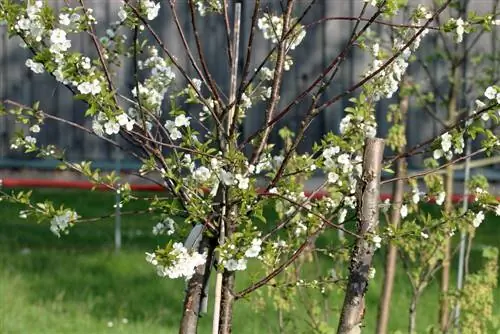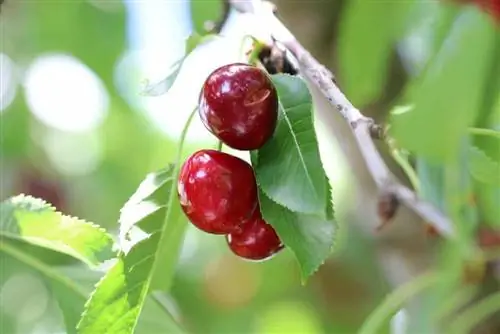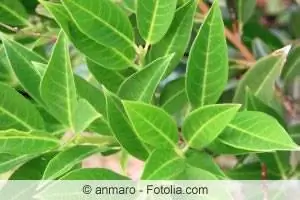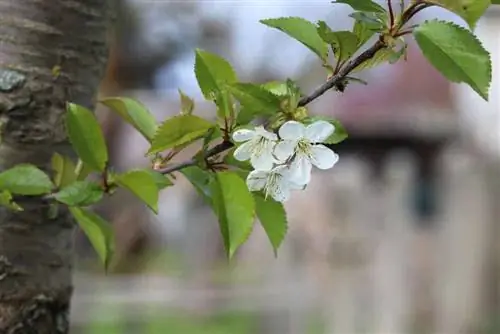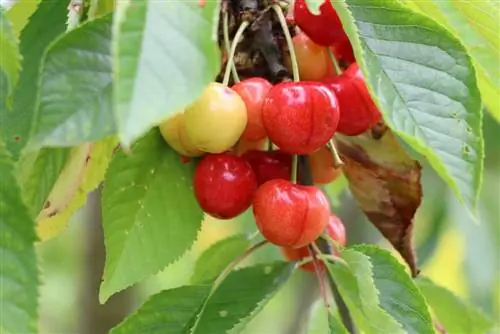- Author admin [email protected].
- Public 2023-12-17 03:39.
- Last modified 2025-01-24 12:45.
The Prunus serrulata 'Amanogawa', is also known as the "Japanese flowering cherry" and belongs to the rose family. The deciduous tree grows slender and upright, which is why the growth habit is called “columnar”. Although some varieties can reach heights of several meters, there are also dwarf varieties that can be easily cultivated in pots.
The Location
The beautiful ornamental trees thrive best in a sunny location, but can also tolerate a place in light shade. However, if you want to promote flower and fruit production, you should plant the tree in a location with full sun. In addition, when planting the tree, sufficient distance from the neighboring plants should be taken into account. Ideally the distance is around 80 to 100 cm.
The substrate
When it comes to soil, the columnar cherry is not particularly picky because it basically gets along well with all types of soil. However, the plant is considered to have deep roots, which is why the soil should not be too compacted. If the soil is too dense, the columnar cherry will spread its roots over a large area, which will affect its growth. In general, the tree thrives best in soil that has the following properties:
- permeable
- nutritious
- sandy and loamy
- slightly calcareous
- pH value slightly acidic to alkaline
- A mixture of garden soil and peat is suitable for cultivation in the bucket
- this is mixed in a ratio of 1:1
The Cultivation
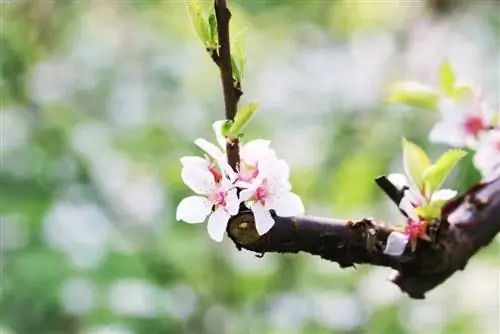
The columnar cherries can be grown both in the home garden and in a container on the terrace. However, it is important to note that some varieties can reach a height of up to several meters. If you still want to cultivate the ornamental plant in a pot, you should definitely have an appropriately sized container and enough space on the balcony or terrace ready.
Cultivation outdoors
If the columnar cherry is grown in the garden, the right place should first be found. Please note that despite its columnar growth, the plant requires sufficient space as it can easily reach a width of up to one meter. Before planting, the root ball should first be watered sufficiently. To do this, it is advisable to place the plant in a bucket filled with water for about an hour. The tree is then planted as follows:
- Dig planting hole
- this should be significantly deeper and wider than the root ball
- loose the soil if necessary
- coarse sand or small pebbles are mixed in
- incorporate a mixture of soil and compost
- Insert root ball
- just as deep as the plant was in the pot before
- this can be recognized by the dark discoloration on the root neck
- The finishing point should be about a hand's breadth above the ground
- Fill planting hole with soil
- water abundantly, literally sludge!
- and top up soil if necessary
Tip:
In order to support the formation and stability of the tree, it is advisable to incorporate a support post into the ground. This is best inserted into the soil in front of the plant and then tied to the tree with a string.
The culture in the bucket
If you don't have a garden, you don't have to miss out on growing this decorative tree. With a little skill, the ornamental cherry can also be cultivated in a bucket. To ensure that the columnar cherry grows optimally in the pot, the right container is essential. The pot should be as high as possible and have a capacity of at least 40 liters. This is the only way to ensure that the roots have enough space and can extend deeper. If the pot is too big, the plant will put too much energy into growing the roots. If it is too small, the roots will be restricted and growth will be impaired. It is therefore advisable to repot the plant as quickly as possible after purchase as follows:
- form a drainage above the drain hole
- Shards of pottery or coarse gravel are suitable for this
- this is important so that the drain hole does not get clogged
- Fill the pot with soil
- Insert plant carefully
- about as deep as it was in the pot before
- Refill soil and press gently
- water abundantly
- Pay attention to the pouring edge, this will make later watering easier
Tip:
To ensure that the roots always have enough space over the years, the tree should be repotted about every 3 to 5 years.
Care
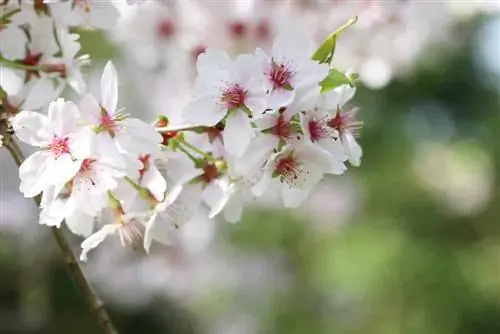
The columnar cherries are considered beginner-friendly because they do not require a lot of care. However, the amount of care required differs depending on the type of cultivation, because the trees in the pot require a little more attention than those in the open field. You can read an overview of professional care here:
Fertilize
The columnar cherry does not require a lot of nutrients, which is why fertilization is only carried out as needed, especially outdoors. As a rule, fertilization with a seasonal fertilizer is only carried out after the first shoots. When choosing fertilizer, make sure that it contains as little nitrogen as possible. Especially from the end of June onwards, fertilization should be carried out with a small amount of nitrogen, otherwise growth will be promoted at the wrong time. From the end of July, the plants are prepared for winter rest with a fertilizer containing phosphorus and potassium. The last time fertilization is carried out around two months before the start of winter, which means that the last fertilization generally takes place in August. In addition, flower formation can be stimulated with a phosphorus fertilizer, although this is usually not necessary as German soils are generally relatively rich in phosphorus.
Pouring
In general, the columnar cherries want to be kept evenly moist after planting. However, it is important to ensure that they are neither too dry nor too wet. In summer, especially when the leaves are drooping, the trees should be watered additionally. To ensure that the plant is always supplied with sufficient moisture, it is worth mulching or creating a moat around the tree disc. When watering these decorative plants, it is also important to note the following:
- It's best to water in the morning or evening
- then the water won't evaporate so quickly
- In winter, only water on frost-free days
- both calcareous and calcareous water are tolerated
Tip:
It is best to only water when the top layer of soil has dried.
Cutting
The columnar cherry should never be pruned too heavily, otherwise the growth habit will be lost. It is best to thin out the crown in the spring before flowering, as this gives new shoots more space to grow. As soon as the tree has reached a height of around one meter, annual trimming or pruning can be carried out. This takes place in the summer immediately after the harvest and is as follows:
- shorten all branches
- leave about two to three eyes
- because this is what makes the fruit wood for the coming year
- Short the leading drive
- This prevents the trunk from becoming bald from below
- cut as vertically as possible and along the trunk
- this prevents water accumulation
Wintering
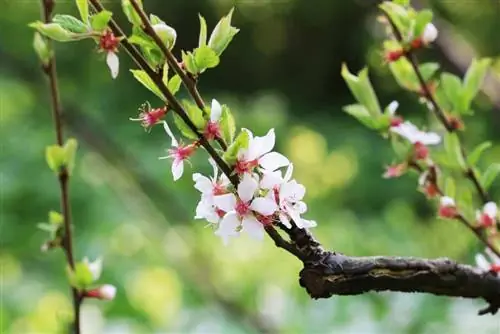
The decorative tree is considered hardy, but plants grown in pots in particular should be protected from frost. For these, it is initially advisable to provide a protective surface. A plate made of wood or Styrofoam on which the container is placed has proven useful for this purpose. It must also be noted that when grown in a bucket, the roots are only surrounded by a small amount of soil and are therefore only partially protected from frost. It is therefore advisable to additionally protect the plants with a fleece or film. To ensure that the trees survive the winter, the following should also be noted:
- do not cut in winter
- only water on frost-free days
- be sure to remove fallen leaves
- there could be frost-resistant fungal spores in it
- these could be passed on to the next shoot
Tip:
If possible, the columnar cherries cultivated in pots should be placed on a southern wall of the house. This not only promises protection, but also stores heat and releases it to the plant.
Harvest
The fruits of the columnar cherry look similar to wild cherries and usually ripen in July. In contrast to the well-known sweet cherries, their taste is less sweet and juicy. Although they are not very popular among people, they are often eaten by hungry birds. But it's not just the fruits that are considered edible, as the flowers of this ornamental tree are also suitable for consumption. These are often used to refine salads or desserts, but they can also be eaten directly from the tree. The leaves of the columnar cherry are considered an insider tip because they are also edible and, thanks to their cherry-like aroma, are ideal for smoothies or salads. If you want to taste the leaves of the tree, you should note the following:
- It is best to pick the leaves shortly after they sprout
- Ideally the medium green ones are colored and very shiny
- because then they have a mild taste
- and the consistency is more pleasant
- because older leaves are usually brittle
Conclusion
The columnar cherry is considered a particularly easy-care ornamental plant, which is suitable for both cultivation in the garden and for cultivation in containers. Although the trees are considered relatively undemanding, they do require a location with as much sun as possible. The fruits of the columnar cherry are not that sweet, but both their flowers and their leaves can be eaten. If you want to decorate your garden with the wonderful flowers, a columnar cherry is a good choice!


